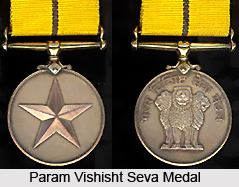 Param Vishisht Seva Medal belongs to the second lot of awards which were introduced in 26 January 1960 with the aim to honour all the defence personals who have served their nation in times of crisis. Param Vishisht Seva Medal has been officially recognised for distinctive services of most exceptional order. Like other awards of peace time this award too includes all ranks of Indian armed forces which include officers from Indian Army Indian, Air force and India navy, territorial armed forces, Auxiliary and reserved armed forces and all other lawfully constructed armed forces. This shall further include those involved in the nursing services and medical assistance. Though this did not include any remuneration or allowance from the Government of India yet it has been recognised for most valuable services by the personals of Indian armed forces at the time of peace or other an in face of the enemy.
Param Vishisht Seva Medal belongs to the second lot of awards which were introduced in 26 January 1960 with the aim to honour all the defence personals who have served their nation in times of crisis. Param Vishisht Seva Medal has been officially recognised for distinctive services of most exceptional order. Like other awards of peace time this award too includes all ranks of Indian armed forces which include officers from Indian Army Indian, Air force and India navy, territorial armed forces, Auxiliary and reserved armed forces and all other lawfully constructed armed forces. This shall further include those involved in the nursing services and medical assistance. Though this did not include any remuneration or allowance from the Government of India yet it has been recognised for most valuable services by the personals of Indian armed forces at the time of peace or other an in face of the enemy.
Param Vishisht Seva Medal in appearance is suspended with a red ribbon with 2mm blue strip going through the middle. While much is not written regarding the appearance of the medal, officially it has been mentioned that if a recipient of the medal is subsequently awarded with the same medal for the same service then it shall be recognised by a bar to be attached with the riband; for every such bar a miniature insignia approved by the government of India shall be added to the riband when worn.
Thus Param Vishisht Seva Medal precedes Vishisht Seva medal and is equivalent Sarvottam Seva medal. This medal is the most honoured medal awarded during peacetime.
This article is a stub. You can enrich by adding more information to it. Send your Write Up to content@indianetzone.com




















